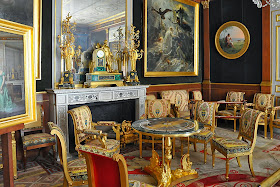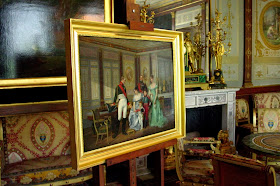Château de Malmaison was a country home of Napoléon and Joséphine, purchased by her before her husband became emperor and crowned her empress in 1804. Malmaison is a little jewel box filled with furniture, sculpture, portraits, porcelain and other personal treasures. It’s small, but it is elegant and beautifully decorated.
As any royal would do she enlisted the top architects of the day, Percier and Fontaine, to provide luxurious details and sumptuous décor – all the efforts of which blew her budget. Upon his return from Egypt, Napoléon clearly forgave his wife for her extravagant decorating venture.
The property achieved enduring fame for its rose garden. She created an extensive collection of roses, gathering plants from her native Martinique and from other places around the world. She grew some 250 varieties of roses.Birds and animals of all sorts began to enrich her garden, where they were allowed to roam free among the grounds. At the height of her days at Malmaison, Joséphine had the company of kangaroos, emus, black swans, zebras, gazelles, ostriches, chamois, seals, antelopes and llamas to name a few.Most of the extensive grounds have returned to their natural state, but there are a few rose and flower gardens.
Napoléon later divorced Joséphine, as she was unable to provide a male heir, and she resided at Malmaison until her death in 1814.
Italian, Gaspare Luigi Pacifico Spontini was Empress Josephine's favorite composer so I thought it would be nice to listen to the music she loved while you visit her home.
Reception at Malmaison in 1802 Painting
From 1800 to 1802 this small castle became, together with the Tuileries, the seat of the French government, and frequently hosted the ministers of the Consulate.
According to his secretary, Malmaison was "the only place next to the battlefield where he was truly himself".
Perhaps the most interesting thing about Chateau Malmaison is the presence of the Empress Josephine that is sensed there. It was after all she who selected and decorated this residence, and after the divorce Napoleon ceded the chateau to her, where she was to live out her days. She and Napoleon had a very stormy relationship. He met her while his star was rising during the Revolution, and fell deeply in love with her.
On the ground floor, their first task was the vestibule: rather than replacing two broken beams on the first floor, the architects supported them with four wooden posts transformed into stucco columns, giving the overall appearance of the atrium of a Roman villa. To open the vestibule onto the adjoining rooms during receptions, a mechanism was installed enabling the mirrors to slide into the walls, thus transforming the billiards room and dining room into reception rooms,
The dining room with its harmony of subtle colors, is a perfect illustration of Pompeian style.
The rounded end of the Dining Room leading out to the stairwell.
Among the existing instruments in the Music Room, the most precious is certainly the harp (from mahogany, golden bronze and pearl), which belonged to Empress.
The harp belonging to the Empress Josephine.
Another of the Music Room's lovely instruments.
This photo is courtesy of TripAdvisor
Beautiful torcheres adorn the Music Room.
The Consulate Chamber is designed to look like a military tent.
The Emperor's chair in the Consulate Chambers.
The Library whose magnificent original decoration has been preserved - contains furniture which was mainly brought from the Tuileries. A secret staircase led Napoleon directly to his rooms on the first floor.
Emperor Napoleon's desk. Sphinxes, winged lions and creatures with heads of eagles were employed as table legs and armrests on chairs. These symbols of power made a direct visual connection between his regime and the glory and authority of the ancient Roman emperors.
In this picture you can see that the room was beautifully decorated from top to bottom. The ceiling is exquisite and notice the stunning rug.
Another image of the Library ceiling.
The Salon doré features two big paintings on the theme of Ossian, six armchairs decorated with Egyptian heads and the fireplace of white marble offered by pope Pie VII in 1802. Salon doré was remodelled to the taste of empress Joséphine by her architect Louis-Martin Berthault.
A close up of the beautiful chairs in the Salon doré.
Josephine's apartments feature velvet covered, gold leafed chairs flanked by painted swans whose image of power is reflected in a coordinating, round, Aubusson carpet indicating that the riches continued to flow at this glorious home. Although Napoleon and Josephine had separate bedrooms, they are believed to have slept together quite often. It was normal in those days for husband and wife to each have their own bedrooms, and even their own suite of rooms if they could afford it.
An image of the room shot from a different angle.
The richest of Malmaison’s decor is found in The Empress’s tented bedroom. While traveling in Milan during the summer of 1812, Josephine decided to have her old bedroom freshened up a bit by architect Louis-Martin Berthault.
I am a fan of the decorated ceiling.....and this one is stunning.
Imagine the delight she must have experienced upon discovering her new bed created by acclaimed furniture maker Jacob-Desmalter – one watched over by golden imperial eagles and flanked on either side by romantic swans and abundant cornucopias.
A more modest space, this is The Emperor’s Bedroom. The regal bed originally came from the Tuileries Palace. Once again crafted by Jacob-Desmalter, the busts of a lovely ladies realized in bronze and decorated in gold, must have kept the emperor in feminine company each night.
Caryatids were a big design element of the Empire style and were used on chairs, tables, and other furniture. This style was influenced by ideas Napoleon brought back from his time spent in Egypt.
The Austerlitz Table, inlaid with Sevres plaques commemorating Napoleon's victory at Austerlitz, 1808-10
The drawing room in the Emperor's apartments.
The pièce de résistance of the artwork at Malmaison is located in Napoleon's chambers. It is Jacques-Louis David’s painting “Napoleon Crossing the Alps.” The big oil on canvas, 8'6"x7'3", is the original canvas of this famous painting (subsequently, David painted four more versions, which are found in museums throughout France).
Napoleon was an avid pool player.
In her garden at the Chateau de Malmaison, Josephine possessed one of the largest collections of roses in Europe.
If you have been to Chateau de Malmaison, I would love to hear comments about your visit.
As you can see many of the images came from www.kto-to.de, a lovely site and worth a visit!
As you can see many of the images came from www.kto-to.de, a lovely site and worth a visit!
Click here to see the previous post!
This blog post was published by
Lisa Farmer

.jpg)
.jpg)


.jpg)


+(1).jpg)



.jpg)
.jpg)

.jpg)


.jpg)
.jpg)
.JPG)
.jpg)






+(1).jpg)











+(1).jpg)
.jpg)

.jpg)
.jpg)
.jpg)
+(1).JPG)





.jpg)
+(1).jpg)


